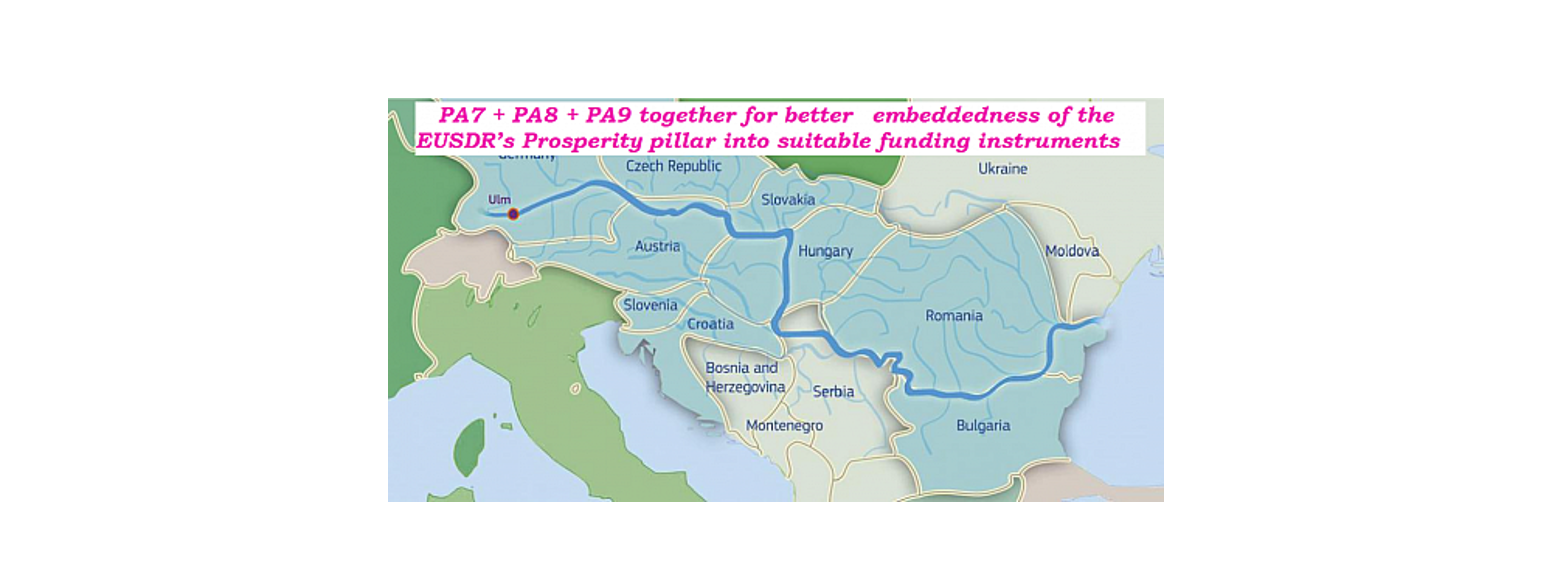In order to address common challenges of the Danube region, the EU Strategy for the Danube Region (EUSDR) was jointly developed by the European Commission together with the Danube Region countries and stakeholders and was endorsed by the European Council in 2011. The territory covered by the EUSDR includes EU Member States (MS) and non-Member States, being very different in terms of economic strengths, research and innovation systems, and profiles.
Through the jointly defined 11 priority fields, the EUSDR supports the development of the whole Danube region. The priority areas 7, 8 and 9 of the EUSDR – summarized under pillar 3 “Building Prosperity” – are putting effort to overcome this gap between up- and downstream countries.
In view of the demanding goals, it was clear from the very beginning, that only a comprehensive approach addressing all available funding instruments can lead the EUSDR activities to success and bring significant development for the whole region. This approach was also stressed in 2011 by the Council of the European Union and the Ministers in charge of the EUSDR of the participating states of the EUSDR and the European Commission committed themselves in 2014 and 20151 to the embedding of the EUSDR (where appropriate and possible) into the programming documents concerning the European Structural and Investment Funds and the Instrument for IPA an their implementation.
However, as the experience showed, this approach didn´t take many measures. Therefore, the Priority Areas 7, 8 and 9 of the EUSDR call on the respective Partner States and the European Commission to take into consideration the following lessons learned for the programming period 2021-2027:
Embedding of the EUSDR into all suitable funding instruments
The European Regional Development Fund (ERDF) and the European Social Fund (ESF) are playing an outstanding role for the economic development of many Member States just as the Instrument of the Pre-accession Assistance (IPA) for the enlargements countries. The above instruments are the most important financial tools when talking about “innovation and research”, the “support for small and medium-sized enterprises (SMEs), “education and training” which are the leading topics of the priority areas 7, 8 and 9 (respect. Pillar 3) of the EUSDR.
As the Danube Transnational Programme (DTP) is financially not strong enough and also has to fulfill other, Interreg-specific goals and needs, it was very clear from the beginning, that also other instruments are needed. In addition, the “Three No´s” of the EUSDR was a very clear commitment towards to use of other funding instruments, which are – under the specific conditions of the Danube region – mainly the instruments from the European Structural Funds. Unfortunately, most of the before mentioned mainstream programmes have chosen the “classical way” of program implementation without an embedding of EUSDR related activities, so that the indispensable creation of synergies was not given. And even though some mainstream programs dedicated sections in their program documents towards the support of macroregional strategies (MRSs), an implementation of this support e.g. by using results of transnational projects for mainstream calls was never reached. If national measures (especially when funded by the EU) should furthermore remain unused to capitalize the potentials of the cooperation, the EUSDR cannot succeed and the work on PA can hardly reach the next level which is going beyond Interreg-related activities.
Therefore for the next programming period, it seems absolutely necessary to better harmonize the programming procedures regards the better embedding of the EUSDR into the mainstream programmes in a multi-stage procedure:
- Opening of Operational Programmes (OPs) of the EU mainstream programs towards MRSs (embedding of a meaningful chapter underlining the support given by the appropriate programme regards synergies)
- Identification of available options in order to foresee EUSDR related facts within the appropriate funding instruments, based on the (new) Action Plan of the EUSDR and the activities of the Priority Areas
Whereas the opening of the national OPs has to be finalized asap (before the programmes´ setup), the integration of EUSDR facts within the concrete funding instruments can be done in a second step, which should fit the time frame for the revision of the EUSDR Action Plan (finalized latest by mid-2019). The necessary coordination of the second stage should be taken over by the Danube Strategy Point and the Trio-Presidency of the EUSDR.
However, the Partner States should also do their “homework” by dedicating meaningful chapters for macro-regional strategies in their programming documents. Last but not least, the concrete formulation of funding ideas and facts for appropriate funding instruments have to be developed by the respective PAs in order to make visible towards the funding responsible people, what exactly is requested. Without precise proposals, this idea will stay conceptional only without any chance of being implemented.
The EUSDR stakeholders already made certain steps in order to convince the future Managing Authorities to reflect on the EUSDR in their operational programmes. Baden-Württemberg like some others made first steps in this direction already in the current period and emphasized the macro-regional strategies and the transnational cooperation in their respective documents.
Harmonized and joint call for proposals Harmonized and joint calls for proposals of available funding instruments could also help to achieve better synergies between mainstream programs and the MRSs. Whereas “harmonized” would only mean “coordinated” (regarding content or time), “joint” would really mean at the same time within on the same topic. Harmonized and joint calls can take into consideration the regional or national focus, and the added value for transnational cooperation arises out of the dynamic caused by reaching more of a “critical mass” within a specific thematic field.
Many good examples, like the “Innovation Express Trans-National joint call for the internationalization of SMEs through clusters” in the Baltic Region Strategy, show that such kind of collaboration between macro-regional strategies, transnational programmes and mainstream or national programmes is possible and could have great success. The “Innovation Express” funding instrument aimed at facilitating internationalization, smart specialization, and cross-border learning and competence development by developing transnational linkages between SME networks, clusters, and other specialized research and innovation nodes – for the benefit of their members. The joint call for proposals was implemented within the framework of the BSR Stars programme – flagship of the EU Strategy for the Baltic Sea Region. The call received support from national/regional funding agencies to initiate, develop or enhance transnational cooperation activities – leveraging cluster organizations (or similar) to develop proposals for their SME members. Unfortunately, in the current financial period, the potentials for harmonized or joint calls were not really taken into consideration within the EUSDR.
As regards the EUSDR, the importance of the mainstream programmes will remain the same even in the next programming period. Based on the above the priority areas 7, 8 and 9 of the EUSDR would highly welcome the possibility to prepare harmonized or joint calls for proposals in the future. Any further support in this direction would be appreciated.
The whole text of the Joint Proposal is available here.




